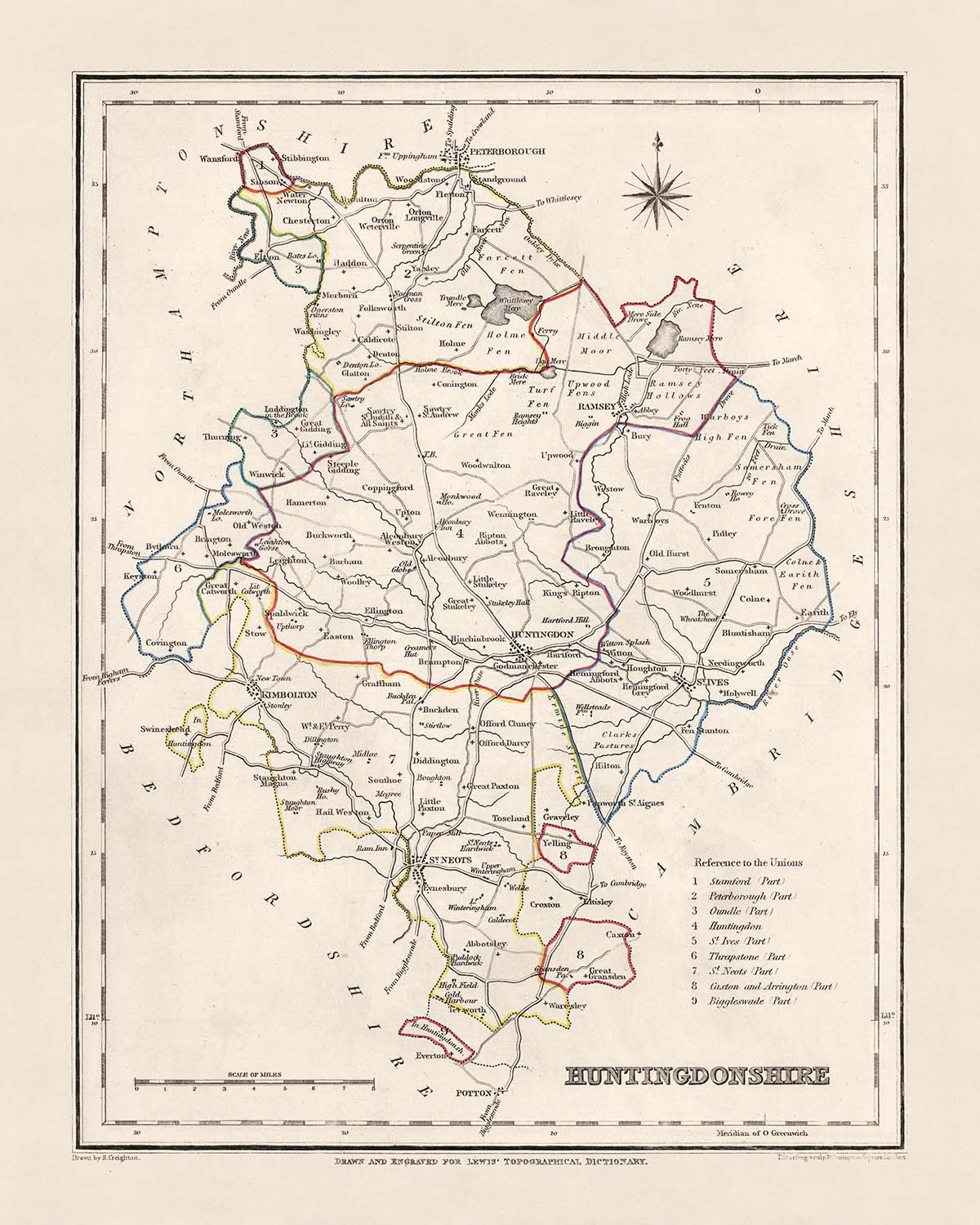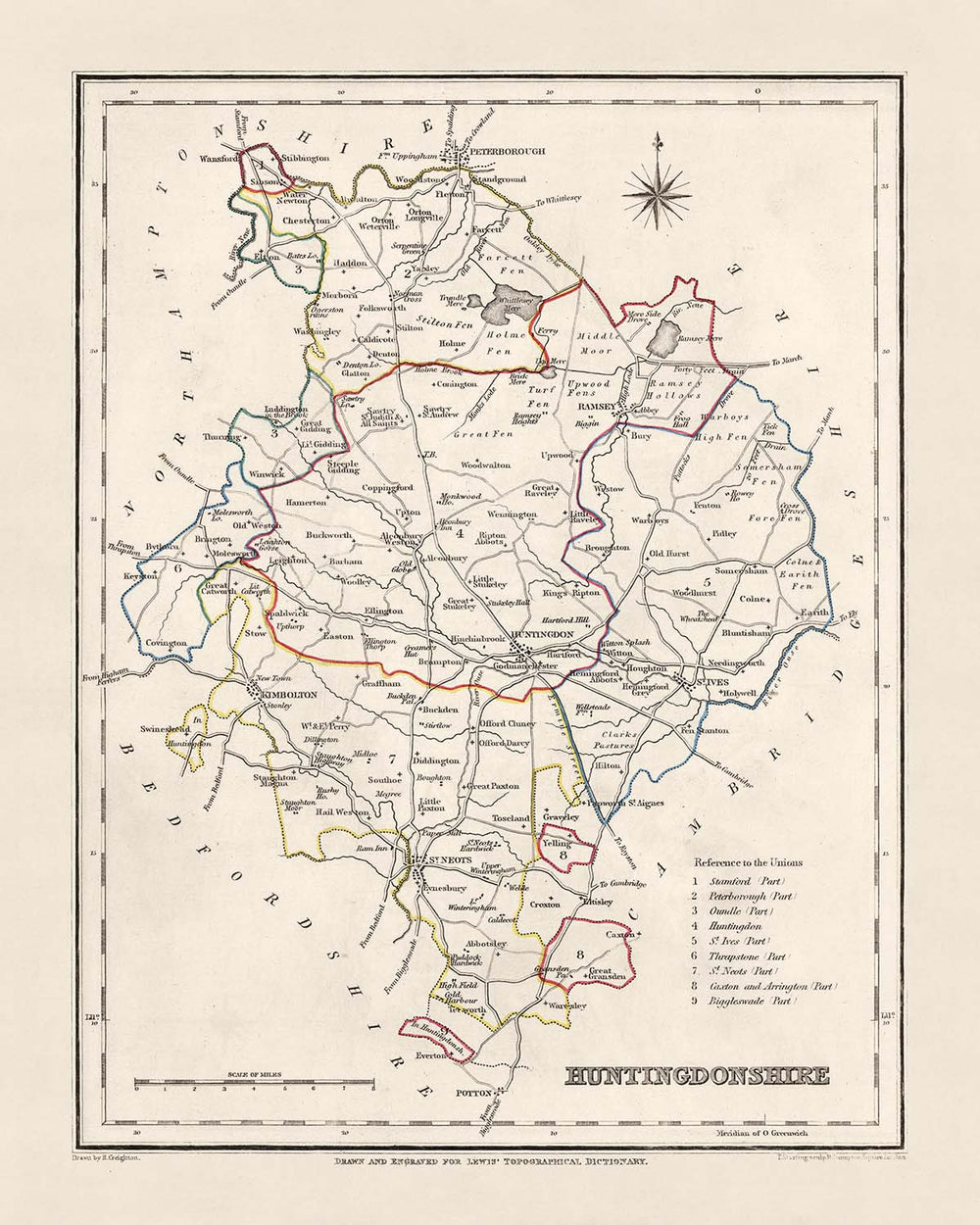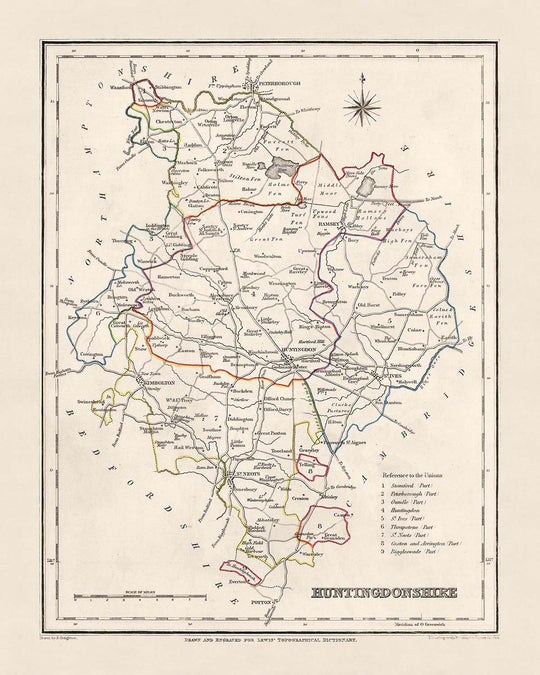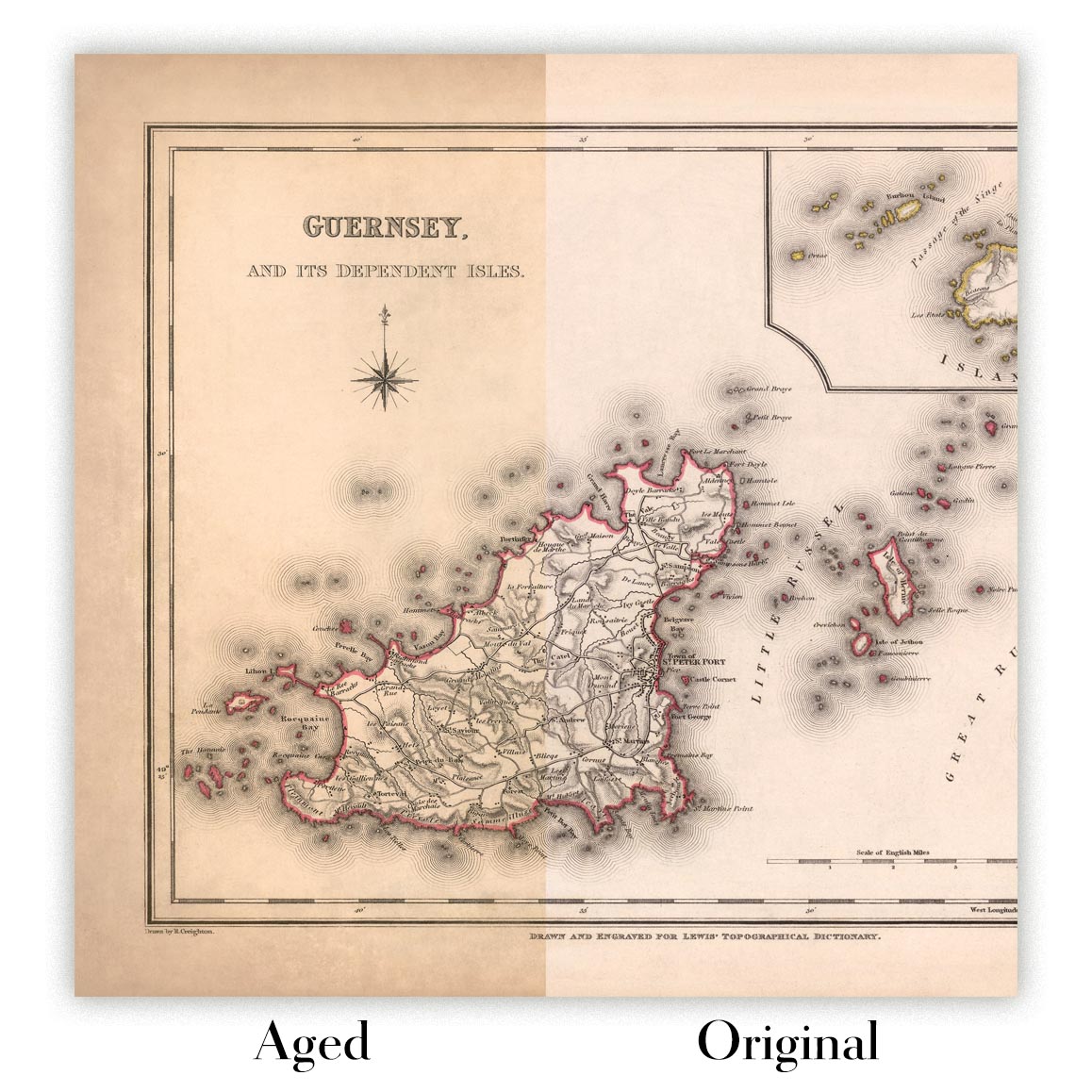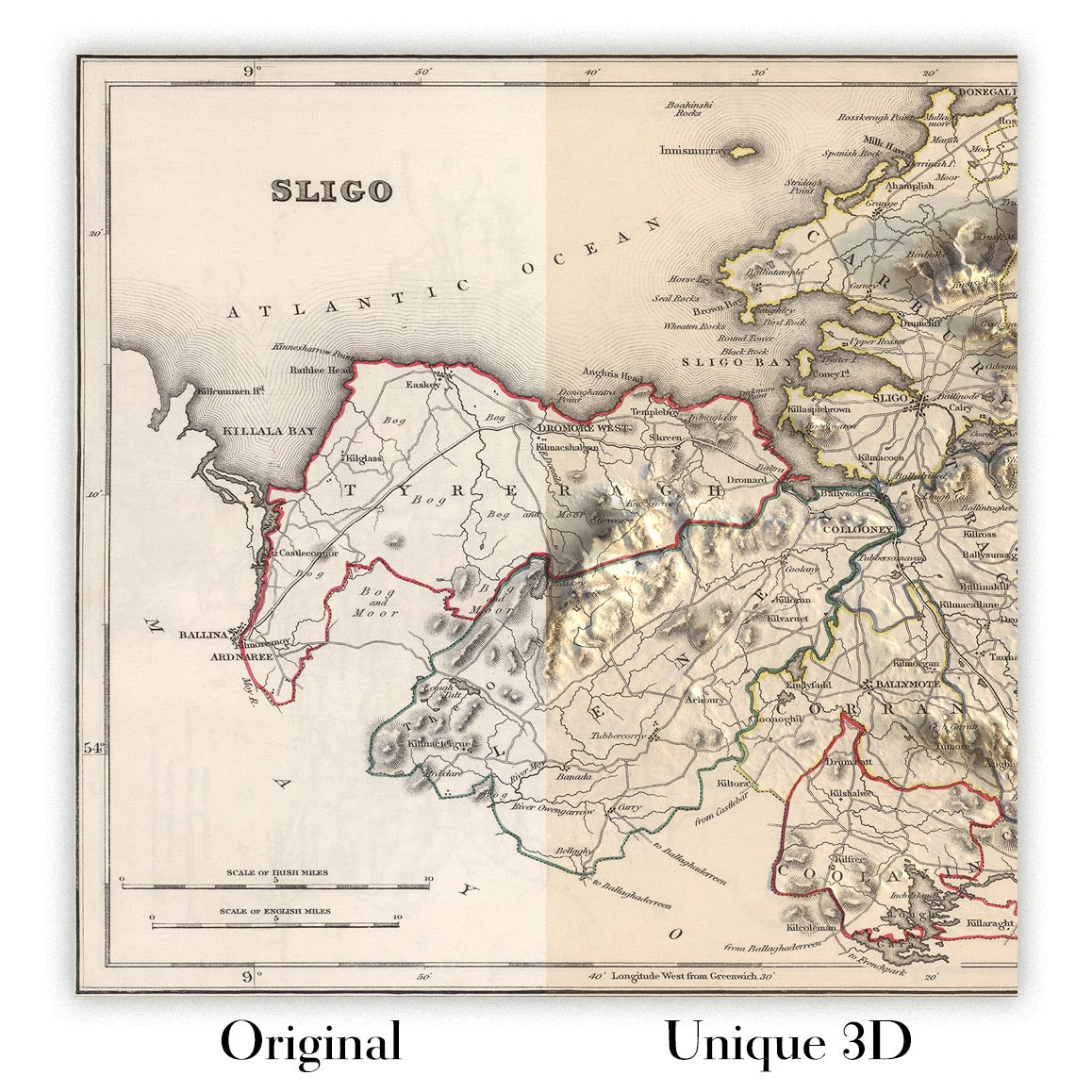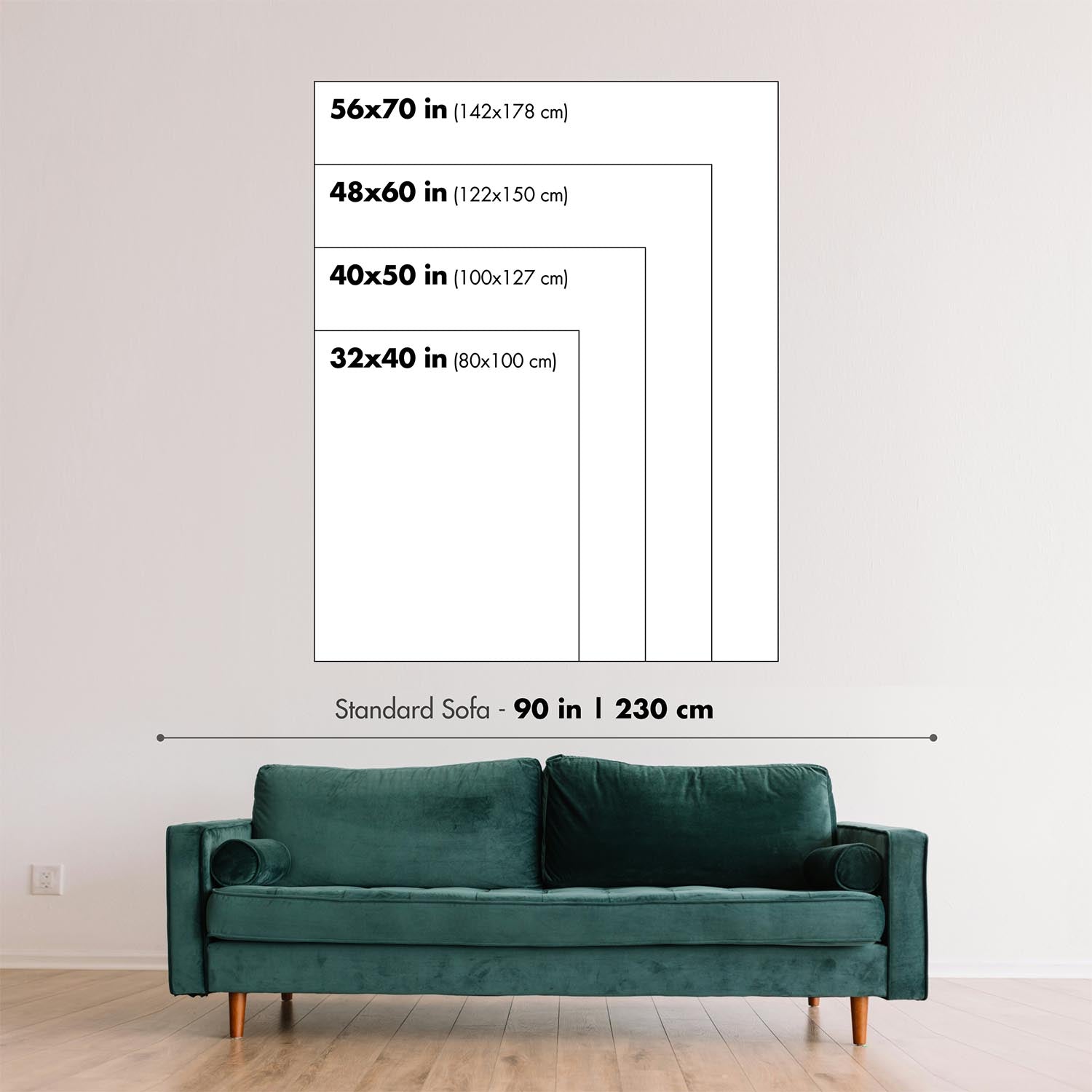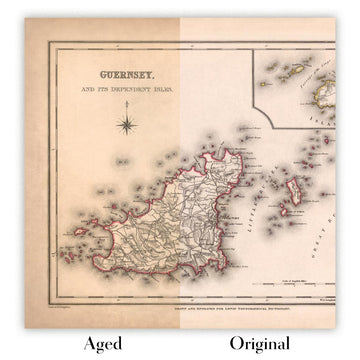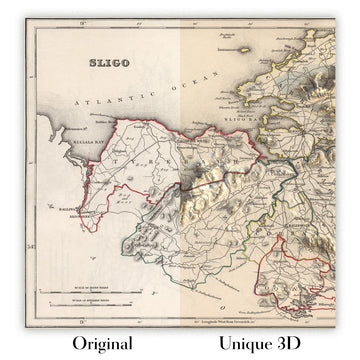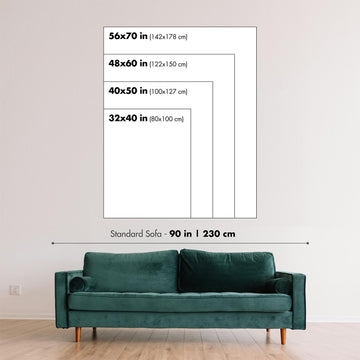- Handmade locally. No import duty or tax
- FREE Delivery by Christmas
- Love it or your money back (90 days)
- Questions? WhatsApp me any time
Own a piece of history
5,000+ 5 star reviews


This Old Map of Huntingdonshire, created by Samuel Lewis in 1844, offers a captivating glimpse into the historical landscape of the county. With its intricate details and elegant design, this map is a remarkable piece of cartographic artistry. It provides a unique opportunity to explore the county's past, showcasing the towns, cities, and other fascinating features that existed during that era.
One of the intriguing aspects of this map is the representation of towns and cities that may have undergone significant changes over time. While some modern cities may not be present on this map, it is exciting to discover the earlier names under which they were known. This adds a layer of historical depth to the map, allowing you to envision the county as it once was.
Here is a list of 30 notable towns, cities, counties, settlements, and colonies that were founded before 1840 and located within the historical boundaries of County of Huntingdonshire, England:
- St. Ives (1086): Known for its picturesque riverside setting and historic bridge, St. Ives is a charming market town that has thrived since medieval times.
- St. Neots (974): With a rich history dating back to Saxon times, St. Neots is one of the oldest towns in the county. It boasts a beautiful riverside location and several notable historic buildings.
- Ramsey (969): Nestled amidst the Fens, Ramsey is an ancient market town that was once an important religious center. Its abbey, founded in the 10th century, played a significant role in the region's history.
- Godmanchester (1212): Situated on the banks of the River Great Ouse, Godmanchester is a town steeped in history. Its Roman origins and medieval layout contribute to its enduring charm.
- Kimbolton (1086): Home to Kimbolton Castle, this village has a rich history dating back to the Domesday Book. The castle, once a royal residence, adds a touch of grandeur to the area.
The historical boundaries of Huntingdonshire also encompassed several other noteworthy settlements founded before 1840:
- Huntingdon (910): The county town of Huntingdonshire, this ancient settlement boasts a long and storied past. It was a significant center during the Roman and medieval periods.
- Yaxley (1086): This village has a history stretching back over a thousand years. It is known for its beautiful lakes and its connection to the poet John Clare.
- Sawtry (1086): With its origins in the medieval era, Sawtry is a village that retains its historical character. It is notable for its medieval church and connections to the poet John Clare.
- Warboys (1086): A village with a rich agricultural heritage, Warboys has roots dating back to the Domesday Book. Its historic church and village green contribute to its timeless appeal.
- Buckden (1086): Situated on the River Great Ouse, Buckden is a village with a fascinating history. It was once home to a royal palace and played a role in the English Civil War.
The County of Huntingdonshire is also blessed with natural beauty and landmarks that continue to captivate visitors today. Some notable features include:
- The River Great Ouse: This majestic river winds its way through the county, offering stunning views and opportunities for boating and leisurely walks along its banks.
- Grafham Water: A reservoir located near the village of Grafham, it provides a picturesque setting for outdoor activities such as sailing, fishing, and birdwatching.
- Hinchingbrooke Country Park: Set within the grounds of Hinchingbrooke House, this park offers tranquil walks, woodlands, and lakes, providing a peaceful escape into nature.
Between 1800 and 1850, Huntingdonshire witnessed several significant historical events. These include the rise of the Industrial Revolution, which brought about changes in agriculture, manufacturing, and transportation. Additionally, the county played a role in the Napoleonic Wars, with the construction of defensive structures along the coast to protect against potential invasions.
Owning this Old Map of Huntingdonshire by Samuel Lewis, 1844, allows you to delve into the county's past, explore its historical settlements, and appreciate the natural beauty that has endured through the centuries. It is a remarkable piece of history that will undoubtedly enhance any collection or serve as a unique decorative piece.
Please double check the images to make sure that a specific town or place is shown on this map. You can also get in touch and ask us to check the map for you.
This map looks great at all sizes: 12x16in (30.5x41cm), 16x20in (40.5x51cm), 18x24in (45.5x61cm), 24x30in (61x76cm), 32x40in (81.5x102cm) and 40x50in (102x127cm), but it looks even better when printed large.
I can create beautiful, large prints of this map up to 50in (127cm). Please get in touch if you're looking for larger, customised or different framing options.
The model in the listing images is holding the 16x20in (40.5x51cm) version of this map.
The fifth listing image shows an example of my map personalisation service.
If you’re looking for something slightly different, check out my main collection of UK and Ireland maps.
Please contact me to check if a certain location, landmark or feature is shown on this map.
This would make a wonderful birthday, Christmas, Father's Day, work leaving, anniversary or housewarming gift for someone from the areas covered by this map.
This map is available as a giclée print on acid free archival matte paper, or you can buy it framed. The frame is a nice, simple black frame that suits most aesthetics. Please get in touch if you'd like a different frame colour or material. My frames are glazed with super-clear museum-grade acrylic (perspex/acrylite), which is significantly less reflective than glass, safer, and will always arrive in perfect condition.
This map is also available as a float framed canvas, sometimes known as a shadow gap framed canvas or canvas floater. The map is printed on artist's cotton canvas and then stretched over a handmade box frame. We then "float" the canvas inside a wooden frame, which is available in a range of colours (black, dark brown, oak, antique gold and white). This is a wonderful way to present a map without glazing in front. See some examples of float framed canvas maps and explore the differences between my different finishes.
For something truly unique, this map is also available in "Unique 3D", our trademarked process that dramatically transforms the map so that it has a wonderful sense of depth. We combine the original map with detailed topography and elevation data, so that mountains and the terrain really "pop". For more info and examples of 3D maps, check my Unique 3D page.
For most orders, delivery time is about 3 working days. Personalised and customised products take longer, as I have to do the personalisation and send it to you for approval, which usually takes 1 or 2 days.
Please note that very large framed orders usually take longer to make and deliver.
If you need your order to arrive by a certain date, please contact me before you order so that we can find the best way of making sure you get your order in time.
I print and frame maps and artwork in 23 countries around the world. This means your order will be made locally, which cuts down on delivery time and ensures that it won't be damaged during delivery. You'll never pay customs or import duty, and we'll put less CO2 into the air.
All of my maps and art prints are well packaged and sent in a rugged tube if unframed, or surrounded by foam if framed.
I try to send out all orders within 1 or 2 days of receiving your order, though some products (like face masks, mugs and tote bags) can take longer to make.
If you select Express Delivery at checkout your order we will prioritise your order and send it out by 1-day courier (Fedex, DHL, UPS, Parcelforce).
Next Day delivery is also available in some countries (US, UK, Singapore, UAE) but please try to order early in the day so that we can get it sent out on time.
My standard frame is a gallery style black ash hardwood frame. It is simple and quite modern looking. My standard frame is around 20mm (0.8in) wide.
I use super-clear acrylic (perspex/acrylite) for the frame glass. It's lighter and safer than glass - and it looks better, as the reflectivity is lower.
Six standard frame colours are available for free (black, dark brown, dark grey, oak, white and antique gold). Custom framing and mounting/matting is available if you're looking for something else.
Most maps, art and illustrations are also available as a framed canvas. We use matte (not shiny) cotton canvas, stretch it over a sustainably sourced box wood frame, and then 'float' the piece within a wood frame. The end result is quite beautiful, and there's no glazing to get in the way.
All frames are provided "ready to hang", with either a string or brackets on the back. Very large frames will have heavy duty hanging plates and/or a mounting baton. If you have any questions, please get in touch.
See some examples of my framed maps and framed canvas maps.
Alternatively, I can also supply old maps and artwork on canvas, foam board, cotton rag and other materials.
If you want to frame your map or artwork yourself, please read my size guide first.
My maps are extremely high quality reproductions of original maps.
I source original, rare maps from libraries, auction houses and private collections around the world, restore them at my London workshop, and then use specialist giclée inks and printers to create beautiful maps that look even better than the original.
My maps are printed on acid-free archival matte (not glossy) paper that feels very high quality and almost like card. In technical terms the paper weight/thickness is 10mil/200gsm. It's perfect for framing.
I print with Epson ultrachrome giclée UV fade resistant pigment inks - some of the best inks you can find.
I can also make maps on canvas, cotton rag and other exotic materials.
Learn more about The Unique Maps Co.
Map personalisation
If you're looking for the perfect anniversary or housewarming gift, I can personalise your map to make it truly unique. For example, I can add a short message, or highlight an important location, or add your family's coat of arms.
The options are almost infinite. Please see my map personalisation page for some wonderful examples of what's possible.
To order a personalised map, select "personalise your map" before adding it to your basket.
Get in touch if you're looking for more complex customisations and personalisations.
Map ageing
I have been asked hundreds of times over the years by customers if they could buy a map that looks even older.
Well, now you can, by selecting Aged before you add a map to your basket.
All the product photos you see on this page show the map in its Original form. This is what the map looks like today.
If you select Aged, I will age your map by hand, using a special and unique process developed through years of studying old maps, talking to researchers to understand the chemistry of aging paper, and of course... lots of practice!
If you're unsure, stick to the Original colour of the map. If you want something a bit darker and older looking, go for Aged.
If you are not happy with your order for any reason, contact me and I'll get it fixed ASAP, free of charge. Please see my returns and refund policy for more information.
I am very confident you will like your restored map or art print. I have been doing this since 1984. I'm a 5-star Etsy seller. I have sold tens of thousands of maps and art prints and have over 5,000 real 5-star reviews. My work has been featured in interior design magazines, on the BBC, and on the walls of dozens of 5-star hotels.
I use a unique process to restore maps and artwork that is massively time consuming and labour intensive. Hunting down the original maps and illustrations can take months. I use state of the art and eye-wateringly expensive technology to scan and restore them. As a result, I guarantee my maps and art prints are a cut above the rest. I stand by my products and will always make sure you're 100% happy with what you receive.
Almost all of my maps and art prints look amazing at large sizes (200cm, 6.5ft+) and I can frame and deliver them to you as well, via special oversized courier. Contact me to discuss your specific needs.
Or try searching for something!







